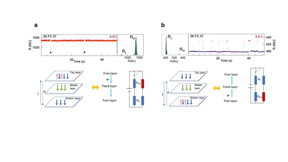Home > Press > Researchers discover a potential application of unwanted electronic noise in semiconductors: Random telegraph noises in vanadium-doped tungsten diselenide can be tuned with voltage polarity
 |
| Time evolution of RTN signals with the corresponding RTN histograms of 1/f 2 feature in the noise power spectra at negative (a) and positive voltage (b). The high-resistance state in the 1/f2 histogram represents antiparallel spin states between layers (a) and the low-resistance state for parallel spin states between layers (b).
CREDIT Institute for Basic Science |
Abstract:
Random Telegraph Noise (RTN), a type of unwanted electronic noise, has long been a nuisance in electronic systems, causing fluctuations and errors in signal processing. However, a team of researchers from the Center for Integrated Nanostructure Physics within the Institute for Basic Science (IBS), South Korea has made an intriguing breakthrough that can potentially harness these fluctuations in semiconductors. Led by Professor LEE Young Hee, the team reported that magnetic fluctuations and their gigantic RTN signals can be generated in a vdW-layered semiconductor by introducing vanadium in tungsten diselenide (V-WSe2) as a minute magnetic dopant.
Researchers discover a potential application of unwanted electronic noise in semiconductors: Random telegraph noises in vanadium-doped tungsten diselenide can be tuned with voltage polarity
Daegu, Republic of Korea | Posted on August 11th, 2023
High contact resistance in lateral devices usually limits the manifestation of inherent quantum states and further degrades the devices performance. To overcome these limitations, the researchers introduced a vertical magnetic tunneling junction device by sandwiching a few layers of V-WSe2, a magnetic material, between the top and bottom graphene electrodes. This device was able to manifest inherent quantum states such as magnetic fluctuations and achieve high-amplitude RTN signals, even with a small vanadium doping concentration of just ~0.2%.
Dr. Lan-Anh T. NGUYEN, the first author of the study said, The key to success is to realize large magnetic fluctuations in resistance by constructing vertical magnetic tunneling junction devices with low contact resistance.
Through the resistance measurement experiments using these devices, the researchers observed RTNs with a high amplitude of up to 80% between well-defined two-stable states. In the bistable state, the magnetic fluctuations in resistance prevail with temperature through the competition between intralayer and interlayer coupling among the magnetic domains. They were able to identify this bistable magnetic state through discrete Gaussian peaks in the RTN histogram with distinctive features in the noise power spectrum.
Most importantly the researchers discovered the ability to switch the bistable magnetic state and the cut-off frequency of the RTN simply by changing the voltage polarity. This exciting discovery paves the way for the application of 1/f2 noise spectroscopy in magnetic semiconductors and offers magnetic switching capability in spintronics.
This is a first step to observe the bistable magnetic state from large resistance fluctuations in magnetic semiconductors and offers the magnetic switching capability with 1/f2 noises by means of simple voltage polarity in spintronics, explained Professor Lee.
This work was done through interdisciplinary research in collaboration with JOO Min-Kyu at Sookmyung Womens University and KIM Philip at Harvard University.
####
For more information, please click here
Contacts:
William Suh
Institute for Basic Science
Office: 82-010-379-37830
Copyright © Institute for Basic Science
If you have a comment, please Contact us.
Issuers of news releases, not 7th Wave, Inc. or Nanotechnology Now, are solely responsible for the accuracy of the content.
Quantum Physics
![]()
A quantum leap in mechanical oscillator technology August 11th, 2023
News and information
![]()
Femtosecond laser technique births “dancing microrobots”: USTC’s breakthrough in multi-material microfabrication August 11th, 2023
![]()
USTC achieved dynamic imaging of interfacial electrochemistry August 11th, 2023
![]()
Simple ballpoint pen can write custom LEDs August 11th, 2023
Physics
![]()
IOP Publishing celebrates World Quantum Day with the announcement of a special quantum collection and the winners of two prestigious quantum awards April 14th, 2023
![]()
Diamond cut precision: University of Illinois to develop diamond sensors for neutron experiment and quantum information science April 14th, 2023
Spintronics
![]()
Quantum materials: Electron spin measured for the first time June 9th, 2023
![]()
Spin photonics to move forward with new anapole probe November 4th, 2022
![]()
Novel nanowire fabrication technique paves way for next generation spintronics November 4th, 2022
Chip Technology
![]()
University of Chicago scientists invent smallest known way to guide light: 2D optical waveguides could point way to new technology August 11th, 2023
![]()
The present and future of computing get a boost from new research July 21st, 2023
Discoveries
![]()
Simple ballpoint pen can write custom LEDs August 11th, 2023
![]()
Chloride ions from seawater eyed as possible lithium replacement in batteries of the future August 11th, 2023
![]()
Tattoo technique transfers gold nanopatterns onto live cells August 11th, 2023
Announcements
![]()
Simple ballpoint pen can write custom LEDs August 11th, 2023
![]()
Chloride ions from seawater eyed as possible lithium replacement in batteries of the future August 11th, 2023
![]()
Tattoo technique transfers gold nanopatterns onto live cells August 11th, 2023
Interviews/Book Reviews/Essays/Reports/Podcasts/Journals/White papers/Posters
![]()
Simple ballpoint pen can write custom LEDs August 11th, 2023
![]()
Chloride ions from seawater eyed as possible lithium replacement in batteries of the future August 11th, 2023
![]()
Tattoo technique transfers gold nanopatterns onto live cells August 11th, 2023










